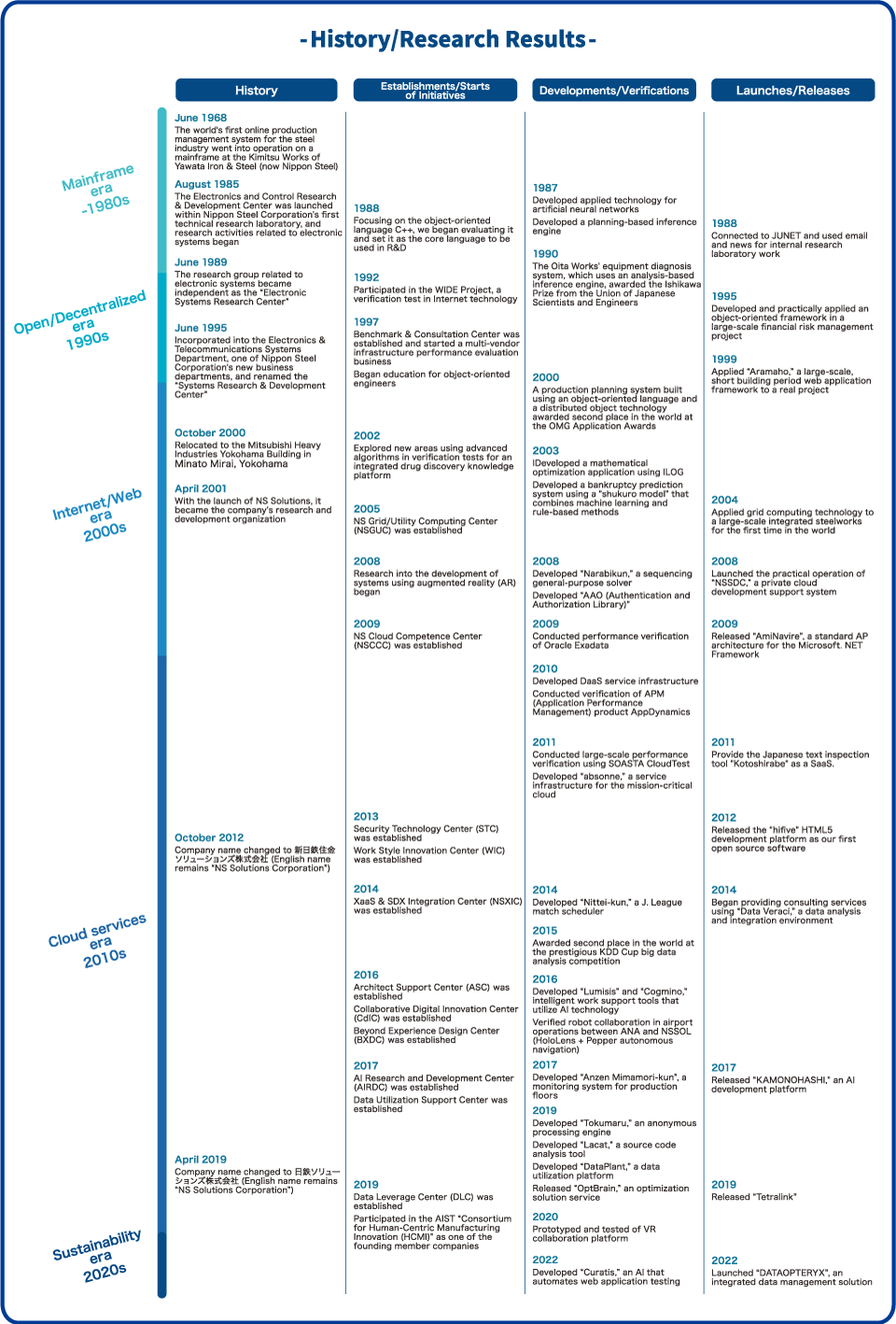Systems Research and Development Center
As the core of our technological capabilities, we engage in cutting-edge research on IT and its practical applications in business.
- Systems Research & Development Center Brochure (PDF: 10MB) (Japanese Only)
- Research Policy
- Organizations
- Activities
- History
Director’s Message
We create a vision for the future of system integrators who apply the latest technologies to solve problems and provide new value, with the aim of realizing sustainable societies, businesses, and systems
Etsuro Minami
Director, Systems Research & Development Center, Technology Bureau
NS Solutions Corporation
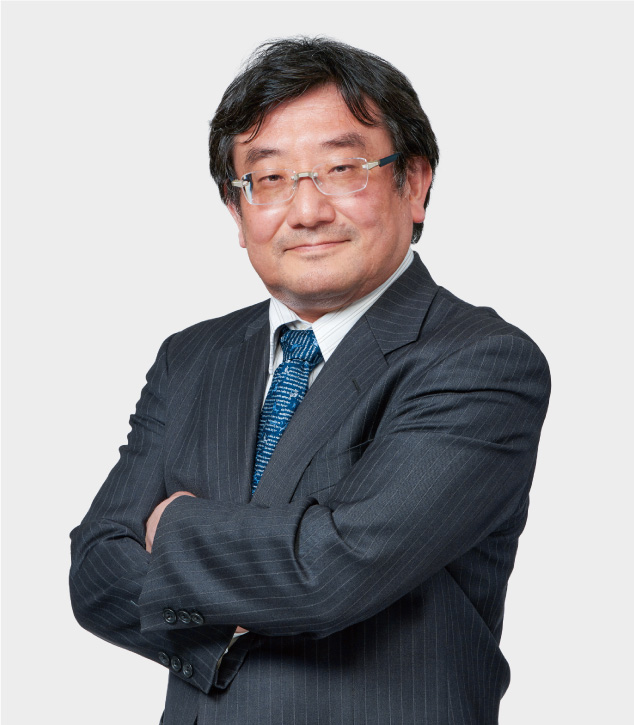
As various social issues such as environmental and resource issues, a shrinking labor force, and geopolitical risks become more apparent, the movement towards a sustainable society has become mainstream in society and business.
On the other hand, the evolution of digital technologies such as machine learning and artificial intelligence is remarkable, and generative AI, in particular, is having a significant impact on society.
It has become an urgent issue to utilize these technologies in a safe way to solve social issues and realize a sustainable society.
At the Systems Research & Development Center, as the research and development department of a systems integrator, we are working to solve issues and conduct research and development to create new value in order to meet the expectations of our customers and society. We identify, master, create, and combine a wide range of technologies in a wide range of technical domains, including digital twins, which digitize various targets in society and business, smart machines, which replace human intellectual tasks or collaborate with humans to solve issues, architectures and processes that quickly and appropriately realize these as systems, and workplaces.
What we value is the practicality of technologies.
In addition to proposing future visions and concepts created through our R&D activities, we work with our customers to test and verify cutting-edge technologies in actual business sites. We also support their implementation into businesses and pursue how systems should be designed to ensure that they continue to function sustainably on a daily basis.
In that design process, we are also actively incorporating the application of cutting-edge technologies, new ways of thinking, and an organizational culture.
We then apply the knowledge gained there to further research and development, refining it into practical technologies.
In order to invigorate these R&D activities and deploy the results to our customers and society, it is essential to develop human resources who can accurately grasp issues and utilize technologies to solve them.
We would like to create a place for fostering the growth of each individual where researchers with specialized knowledge can leverage each other's knowledge and skills to work on technologies that they find interesting and provide innovative technologies that bring surprises to society.
At the Systems Research & Development Center, through a wide range of activities, including research and development, applications in actual business, and human resource development, we would like to create a future vision of integrators who will produce new value for society while working together with all of you to design ways to utilize digital technology and promote its implementation in society.
Three Future Goals
At the Systems Research & Development Center, we have set three “future goals” as our vision for the realization of “sustainability” for society as a whole. These targets are based on our many years of experience and know-how in the searching, evaluation and verification of new technologies, and support for the introduction of new technologies to client companies, considering the uncertain situation of technological evolution, business trends, social environment, and changes in people's values.
Future Goals 1: “The Ultimate Digital Twin”
Replicating and reproducing into the digital world
Going beyond the narrow definition of a digital twin that digitizes real-world entities, we aim to achieve the ultimate digital twin. A digital twin that integrates all kinds of objects into the digital world by digitizing things that have already been turned in to data and systematized, as well as implicit knowledge and the human consciousness, etc.
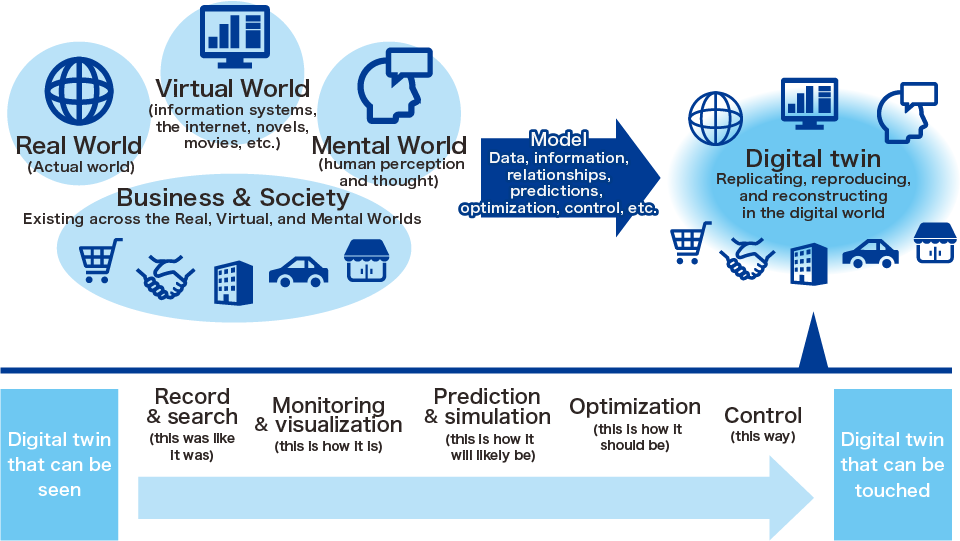
Future Goals 2: “Artificial intelligence that can understand and perform tasks”
Building AI that is almost equivalent to human beings with maximum effort
Companies aim to realize AI that can collect the information necessary for the task, understand the content of the work and the specifications of existing systems, and generate new information systems, as well as AI that can efficiently execute operations.
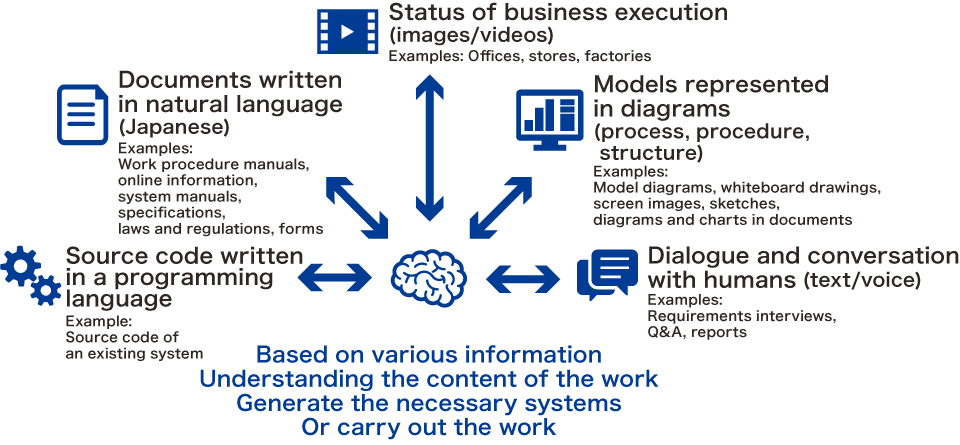
Future Goals 3: “Sustainable corporate information systems”
Creating long-lasting systems that are responsive to change
We aim to realize a sustainable information system that can respond to changes in society, business environments, and technologies. We pursue modular architecture, agile development and DevOps, cloud-native, and incorporating AI into systems.
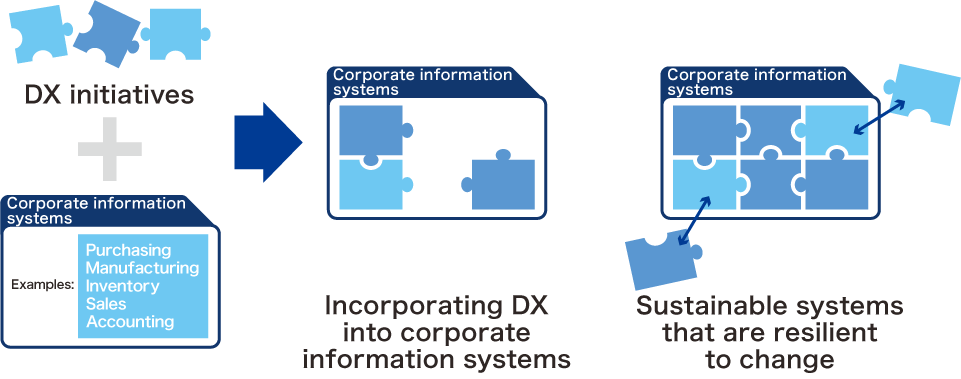
Digital Twin Research Department
A digital twin is a technology that recreates the real world and migrates it to the digital world.
Digital Twin Research Department aims to realize the ultimate digital twin, which encompasses not only the real and digital worlds but also the mental world (human intentions and intellectual abilities). By making full use of IoT, prediction and simulation, mathematical optimization, AR/VR, and robot control technologies, we respond to the need for understanding of the state of society and our customers' businesses, planning and accelerating the management decisions of our customers.
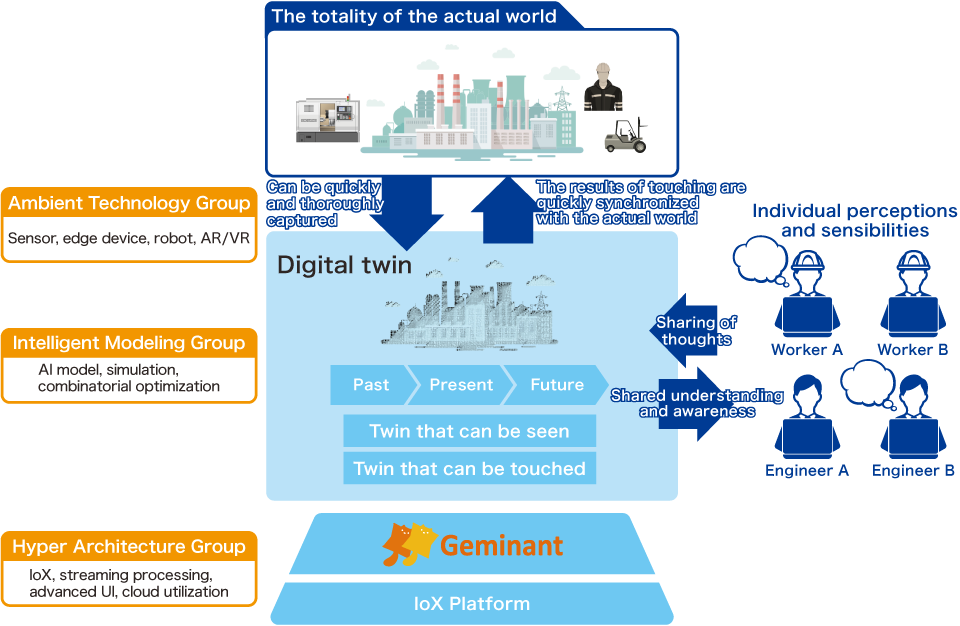
- *See “Product List” for the logos in the diagram
Intelligence Research Department
Intelligence Research Department will deliver systems that support human intellectual work, and contribute to the advancement of our customers’ operations and the improvement and reform of their businesses. This will be done through research and development of architectures and processes that consider “advanced intellectual processing technology/data utilization technology” and “data utilization life cycles” for the continuous use in actual operations.
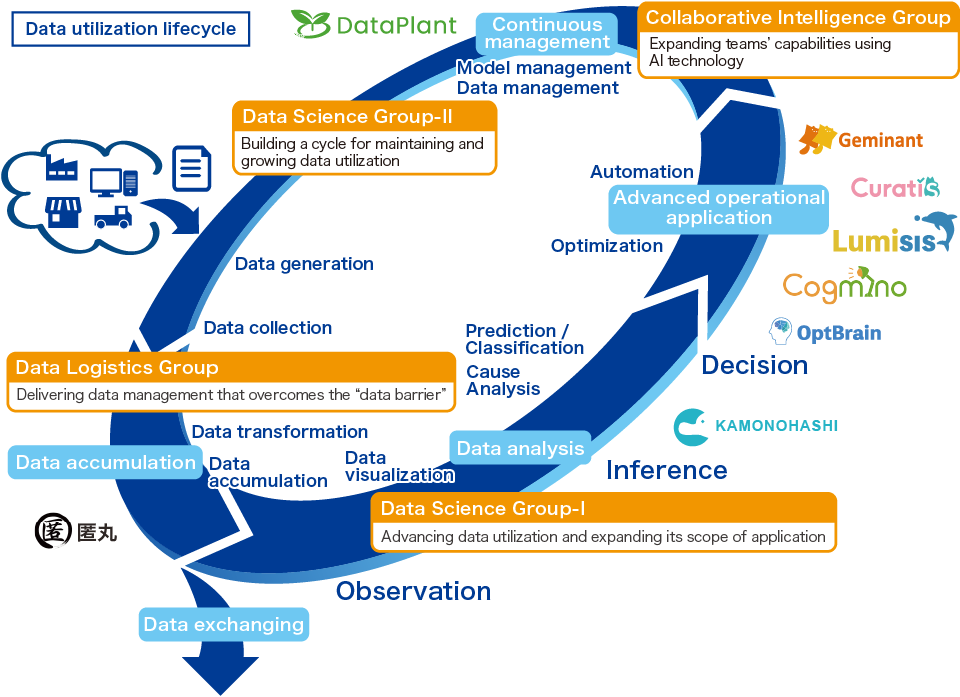
- *See “Product List” for the logos in the diagram
Architecture & Process Design Research Department
Architecture & Process Design Research Department is researching system architectures and system development and operation processes that will realize the next-generation SI model and asset utilization model set out in the “NSSOL 2030 Vision,” as well as methods for developing the necessary human resources for their utilization. Even amid the various constraints, we will realize a sustainable corporate information system that can continuously contribute to the creation of customer value by flexibly and efficiently promoting the digital transformation of our corporate information system.
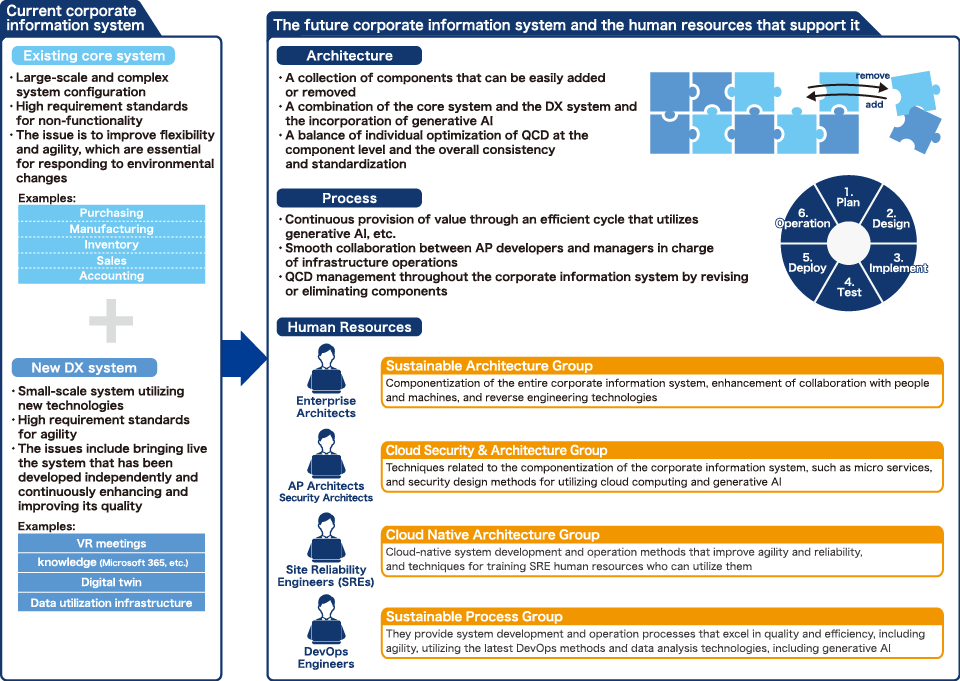
Service Design Research Department
The Service Design Research Department conducts human-centered experience design and service design, creates products and services, leads agile development, and supports continuous value proposition. In addition, providing comprehensive support for human resource development, processes, and agile organization contributes to maximizing the outcomes of products and services.
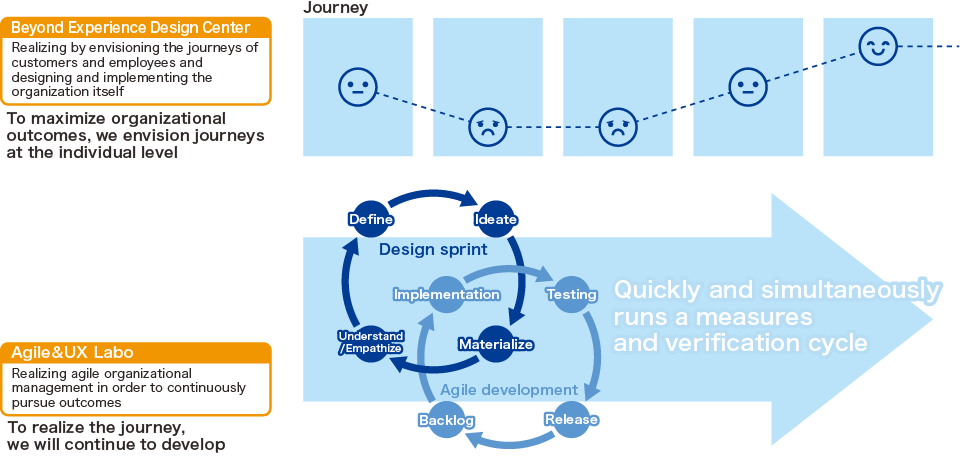
R&D Strategy Management Department
The R&D Strategy Management Department is engaged in the following activities with the aim of enhancing research and development capabilities.
- “Developing research strategies” to examine research target areas, and “promoting exit strategies” to promote the application of research results
- “Research theme execution management” starting with visualization and dissemination of R&D activities
- “Research environment improvement” to ensure that each researcher can work comfortably
Through these activities 1 to 3, we aim to improve the quality and efficiency of our R&D activities, and to provide higher research and development results to our customers and society more quickly.
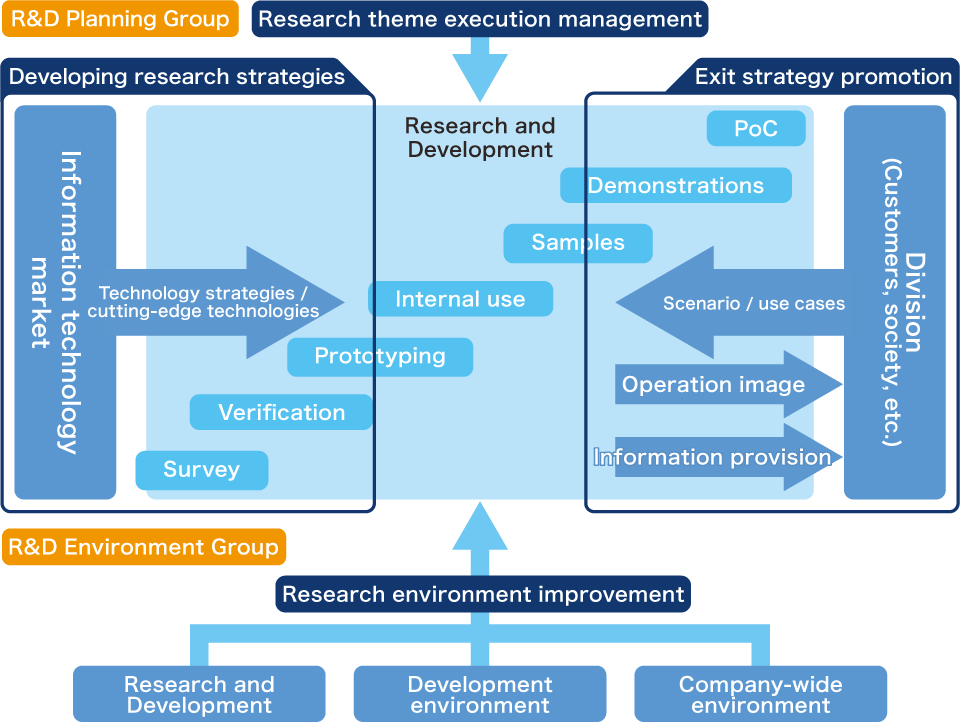
Product List
Here is an introduction of the products being developed by the Systems Research & Development Center. We are utilizing the products for in-house projects, etc.
If you are interested, please contact the sales representative in charge or use the inquiry form on our website.
| Product name | Explanation |
|---|---|
 |
Cogmino is a concept searching system that allows users to find useful information from the vast amount and variety of information within an organization using vague keywords (concepts). By implementing Cogmino, anyone can quickly find the information they are looking for, reducing the time spent searching for it and allowing them to focus on creating new value. (Currently only for internal use) |
 |
Lumisis is an AI for management that takes over the routine duties of the project leader. It evaluates the grammatical structure and formatting of the project members' reports, and reviews the reports to ensure they address all the essential aspects (such as the 5W1H: Who, What, When, Where, Why, and How). It can reduce the project leader’s workload by requiring revisions until a predetermined standard is met, and at the same time, it can support them so that they can focus on their core duties. It can also enhance communication flow within the project. (Currently only for internal use) |
 |
Geminant is a set of components for visualizing digital twins. By inputting various data obtained from the production floor into a predefined model, it is possible to build a digital twin on the web that shows the “past” and “present” without having to create individual screens. By using a common data model, it becomes possible to analyze from various perspectives, thereby eliminating the gaps in perception that arise from differences in position, such as management, engineers, and on-site workers, and solving issues in the field. (Considering selling externally) |
 |
KAMONOHASHI is an AI development platform designed to streamline the development of deep learning models. It solves the three issues that arise in AI development of “environment settings,” “reproducibility,” and “resource sharing” by “containerizing the environment,” “recording all learning input and output,” and “automatically assigning jobs.” It provides an environment where AI developers can concentrate on AI development. (Currently available as OSS on the following site)
|
 |
Lacat is a static analysis service for Java that supports impact analysis and regression testing in "derivational development" (enhanced development). It enables development efficiency, efficiency in maintaining existing functions, and reduction of technical debt (refactoring). (Currently only for internal use)
|
 |
Tokumaru is an engine that supports anonymization and pseudonymization processes. It enables anonymization and pseudonymization in 5 steps. The software supports the proper processing and evaluation of data by providing a wide range of processing methods that comply with guidelines and a function for creating visual reports for evaluating usefulness and safety. Combining this with NSSOL's data distribution consulting menu supports the execution of new businesses that exchange safe and useful data with external parties. (Consultation available for external sales)
|
 |
OptBrain is a service that supports everything from application consulting to system building of optimization solutions that automatically plan production, logistics, etc. By “isolating problems in a way that leads to problem-solving,” “automating(standardizing) in a manner that takes into account even vague conditions for consideration that are not forced,” and by “isolating problems in a manner that can be technically resolved,” we will realize and optimization system that can be integrated into operations and has long-lasting effectiveness. (We are currently considering external sales) |
 |
Curatis is an AI that automates web page testing (E2E testing) in system development. Using deep learning, it understands the meaning of text in test specification documents, manipulates the user interface, and verifies the results. It leverages features such flexible instructions expressed in natural language, no-code, high productivity, and robust in handling modifications. It aims to make it easier to enhance the quality of systems, enabling project teams to focus on higher value-added activities and enabling users to confidently and swiftly add or update valuable features. (Currently only for internal use) |
 |
cloadios is a continuous performance testing platform that enables load testing compatible with agile cycles. By pursuing automation through the management of test scenarios using code, CI/CD frameworks, and the use of container orchestrators to manage containers that generate load, it is possible to perform continuous load testing. Also, by using a public cloud, the time required to build a load generation environment can be shortened, and costs can be reduced because there is no need to purchase commercial load testing tools. There are also many cases of success (Currently being offered as a service by the Benchmark & Consultation Center, a specialist team for system performance management)
|
Other Sustainability Promotion Activities
Here is an introduction of the social contribution activities being developed mainly by the Systems Research & Development Center.
K3Tunnel
K3Tunnel is a website based on the concept of “learning through programming.”
The site offers visual programming tools that focus on calculations, as well as learning content unique to system integrators.
We are engaged in a variety of activities utilizing K3Tunnel, with the dream of realizing a world where “everyone uses IT creatively”. Among our social contribution activities, our visiting lectures to elementary and junior high schools and seminars for teachers have been very well received.
In addition, a wide range of volunteer members are involved in the planning, development, and operation of K3Tunnel, resulting in a variety of collaborations both inside and outside the company.
We will continue to take on various challenges and create a platform where people from inside and outside the company can connect and learn.
- Achievements to date
- K3Tunnel Portal Site
- Official YouTube Channel
- Official X (formerly Twitter) account: @k3tunnel(We update this account with updated information, event information, etc.)
In addition to this, the Systems Research & Development Center is also engaged in social contribution activities such as dispatching lecturers to Institute of Science Tokyo, the Future University Hakodate, and the University of Aizu.
Chronology
We started out in 1986 with a research team of just three people, and have achieved a variety of accomplishments since then. Here is an introduction of the history of the company to date.
